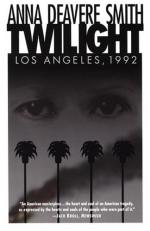|
This section contains 311 words (approx. 1 page at 400 words per page) |

|
Twilight: Los Angeles, 1992 Summary & Study Guide Description
Twilight: Los Angeles, 1992 Summary & Study Guide includes comprehensive information and analysis to help you understand the book. This study guide contains the following sections:
This detailed literature summary also contains Further Study and a Free Quiz on Twilight: Los Angeles, 1992 by Anna Deavere Smith.
Twilight: Los Angeles, 1992 is the fourteenth part of Anna Deavere Smith's work in progress, On the Road: A Search for American Character, begun m 1983. The play's unifying focus is the civil unrest in Los Angeles following the April, 1992, verdict in the first Rodney King trial, presented from the perspective of the wide range of persons that Smith interviewed. The actress-playwright interprets a limited number of these actual people in her solo performances, editing and rearranging her raw material as she deems appropriate.
Although she conducted about 175 interviews for the project, in her one-woman performances Smith limits her dramatis personae to between twenty-five and forty-five personalities, depending on her production venue. Her choices have varied as Smith has worked on her command of the diverse people that she represents.
Twilight: Los Angeles, 1992 began its premier run on May 23,1993, in Los Angeles, at the Center Theatre Group/Mark Taper Forum, which had commissioned the work. It received almost unanimous critical acclaim, and it has since gained favorable notice in subsequent productions in Princeton, New Jersey, and in New York, Washington, D. C., and London, England. It has also garnered several honors, including Obie, Drama Desk, and Outer Critics Circle awards and two Antoinette Perry nominations.
Although Twilight: Los Angeles, 1992 was also nominated for a Pulitzer Prize, the Pulitzer jury disqualified it on the grounds that it was not fictional and could only be performed by the interviewer-playwright herself. More than anything else, that decision reflects a critical inability to pigeonhole the work into some familiar category. The play's kinship with the documentary is unquestioned, but it simply escapes any easy classification. Its intention is clear, however; the piece documents a critical time of racial division and civil unrest, not to place blame for what happened, but to help the process of healing through a kaleidoscopic and sympathetic rendering of different viewpoints.
Read more from the Study Guide
|
This section contains 311 words (approx. 1 page at 400 words per page) |

|



